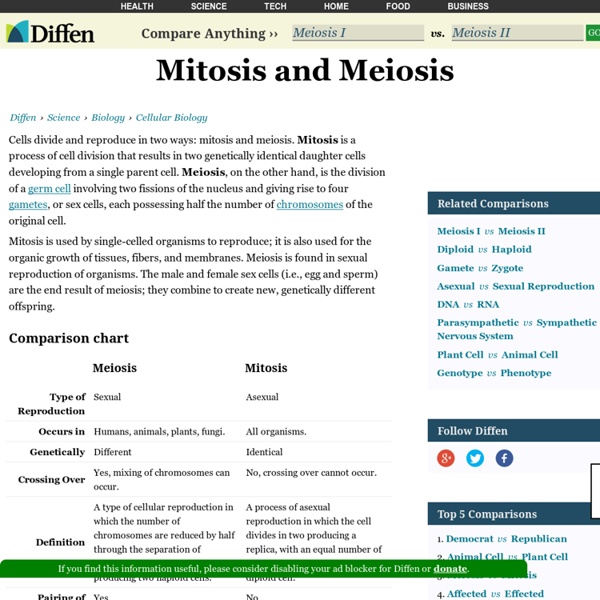Meiosis vs Mitosis

Sex Cells
Sex cells are also called gametes. The gametes are the sperm and the egg; the more scientific terms for these cells are the spermatozoa and ova, respectively. These cells are made only in gonads, and they are made by a type of cell division that doesn't occur anywhere else in the body-- meiosis. You have probably learned about meiosis in a previous class, but I will review it a little bit here... Meiosis, on the other hand, is only used for making gametes! The second reason that we have to use meiosis is because we need our spermatozoa and ova to contain only half of the normal amount of genetic information. Meiosis begins with one cell, called a germ cell (because it specifically makes gametes). Our cells have two copies of every type of chromosome. Use the diagram to follow the description in the next paragraph. Before our germ cells undergo meiosis, they proceed through DNA replication, during which every chromosome is copied.
Mitosis Internet Lesson
Name: ________________________________________ In this internet lesson, you will review the steps of mitosis and view video simulations of cell division. You will also view an onion root tip and calculate the percentage of cells at each of the stages of cell division . Mitosis Tutorial at On the left side of the screen is a navigation bar, click on the link to “MITOSIS” Read the text on this page and view the animation, you can slow down the video by clicking step by step through the phases. 1. Watch the video carefully. 2. -- How many are in each daughter cell at the end of mitosis? --The little green T shaped things on the cell are: ____________________________ -- What happens to the centrioles during mitosis? 3. Another Mitosis Animation Go to . Onion Root Tip Online Activity at Read the introduction, then click the “next” button. You Draw It!
What is a gene mutation and how do mutations occur?
A gene mutation is a permanent alteration in the DNA sequence that makes up a gene, such that the sequence differs from what is found in most people. Mutations range in size; they can affect anywhere from a single DNA building block (base pair) to a large segment of a chromosome that includes multiple genes. Gene mutations can be classified in two major ways: Hereditary mutations are inherited from a parent and are present throughout a person’s life in virtually every cell in the body. These mutations are also called germline mutations because they are present in the parent’s egg or sperm cells, which are also called germ cells. When an egg and a sperm cell unite, the resulting fertilized egg cell receives DNA from both parents. Genetic changes that are described as de novo (new) mutations can be either hereditary or somatic. Somatic mutations that happen in a single cell early in embryonic development can lead to a situation called mosaicism.
Related:
Related:



